Since 2008, Bart and Tim, ‘The Horological Brothers’, have produced a variety of unique mechanisms including a tourbillon minute repeater, a jumping seconds, a flying tourbillon with hacking seconds, and more. Known for their impressive movements where one could wear the watch on the movement side as they are extremely beautiful, they have finally decided to go chrono and present their first chronograph. Their own unique take on classical watchmaking led to them winning two prestigious GPHG prizes for the ‘Best Tourbillon’ with the Parallax model in 2014 and the ‘Best Men’s Watch’ with the 1941 Remontoire in 2016.
Bart and Tim Grönefeld have named their baby the 1941 Grönograaf. The latest creation to be conceived in Oldenzaal, Netherlands is a classical chronograph, but consistent with the Grönefeld ethos, it incorporates several ingenious details.
It was perhaps inevitable that Bart Grönefeld, would follow in the footsteps of his forefathers and become a watchmaker. Having completed his studies at the technical school in his hometown of Oldenzaal, Bart enrolled at the school for watch technicians in Rotterdam. Already passionate about watchmaking, Bart’s fascination for horology grew exponentially when he attended WOSTEP in Neuchâtel, Switzerland. It was here that his teacher, Mr. Antoine Simonin, showed the young man various pocket watches equipped with different complications. One particular pocket watch that Bart saw, featured steel bridges, a detail that provided the inspiration for Grönefeld’s distinctive stainless-steel bridges.
Similarly, Tim Grönefeld’s exposure to complications began at watchmaking school and was further heightened working on various complications in Le Locle. Again, it was Tim’s exposure to complex mechanisms that served to heighten his fascination with classical watchmaking.
Bart and Tim Grönefeld ‘The Horological Brothers’
Unlike mass-produced cam-actuated chronographs, the 1941 Grönograaf features a classical configuration, namely a column-wheel and lateral coupling, a combination synonymous with high-end watchmaking. The calibre G-04 is a symphony of 408 parts and a wonderful exemplar of no-compromise watchmaking.
Mindful that chronograph movements are often subject to harsh forces that can sometimes scar hammers and bend hands, The Horological Brothers conceived a less aggressive system, a ‘soft reset’ mechanism. A centrifugal governor, positioned at 4 o’clock, typically seen on minute repeaters, slows down the reset function, thereby proving kinder to components while delivering a fascinating spectacle in the process. The governor includes two solid gold weights.
Depending on the position of the heart-shaped cams for the counter hands, the relevant minutes and seconds hands rotate clockwise or counterclockwise, heightening the sense of mechanical theatre. The 30-minute counter, located at 6 o’clock, features instantaneous jumping minutes.
The ruby jeweled hammers lessen the impact when returning to zero. The keyless works feature a conical winding pinion and crown wheel, delivering a smooth winding action. Every detail is intended to augment refinement. The variable inertia balance mitigates positional influence and offers superior rate stability. The Philips terminal overcoil enhances isochronism, effectively causing the balance spring to breathe more concentrically.
The main plate is embellished with spots, while the bridges are formed of stainless steel, polished by hand. Moreover, the bridges have micro-blasted centers, circular graining on the top, and feature various engravings in relief. The heart-shaped cams, the elongated chronograph bridge, the gold chatons, and the screw-heads are embellished with black polishing, performed in the traditional way using diamond paste on a tin plate. Consistent with earlier Grönefeld watches, the finishing is worthy of the term ‘Haute Horlogerie’. Indeed, everything is reassuringly Grönefeld.
In 2016, Bart and Tim released the 1941 Remontoire, honoring their father, Sjef, by referencing the year of his birth. The new Grönefeld 1941 Grönograaf features the same 1941 case shape and design but now measures 40 mm in diameter instead of the 39.5 mm on its 1941 case predecessors. However, most notably, the case for the inaugural models, a limited edition of 25 pieces, is formed of the rare metal, in this case, tantalum. This material is hard, corrosion-resistant, bioinert, and exhibits a lustrous, blue-grey gleam. Tantalum is more than twice as dense as stainless steel, heavier than palladium, and slightly lighter than gold. Thereafter, Grönefeld will release 188 pieces in stainless steel.
The hours and minutes are shown on an off-centered dial, a detail that first appeared on the 1896 One Hertz and later on the Parallax tourbillon. The time is expressed with Lancette hands and the hours are denoted with crisp, trapezoidal indexes. The hands are flame-blued steel, upholding watchmaking tradition, while the centers are mirror polished. The centrifugal governor sits at 4 o’clock. When the reset to zero pusher is pressed, the governor bursts into life, not only serving a functional role but delivering a wonderfully animated performance. A 30-minute counter, located at the base of the dial, features a Breguet-style hand. The instantaneous jumping minutes facilitate ease of read-off. A subsidiary seconds display resides at 9 o’clock, while a power reserve indicator, positioned above, is equipped with a pointer, seemingly floating adjacent to a track, conveying the status of the mainspring. The central chronograph seconds hand subscribes to the classical Breguet style and converses with a crisply-marked track positioned on the rehaut, proclaiming the elapsed seconds in an intelligible format.
The 1941 Grönograaf is the distillation of three generations of watchmaking know-how, of the professional journeys of both Horological Brothers, and the manifestation of their extraordinary passion for horology.
Sticker Price €165,000 Euro —approx $168,000 USD— for tantalum, and €155,000 Euro —approx $157,750 USD— for stainless steel. For more info on Grönefeld click here.
























